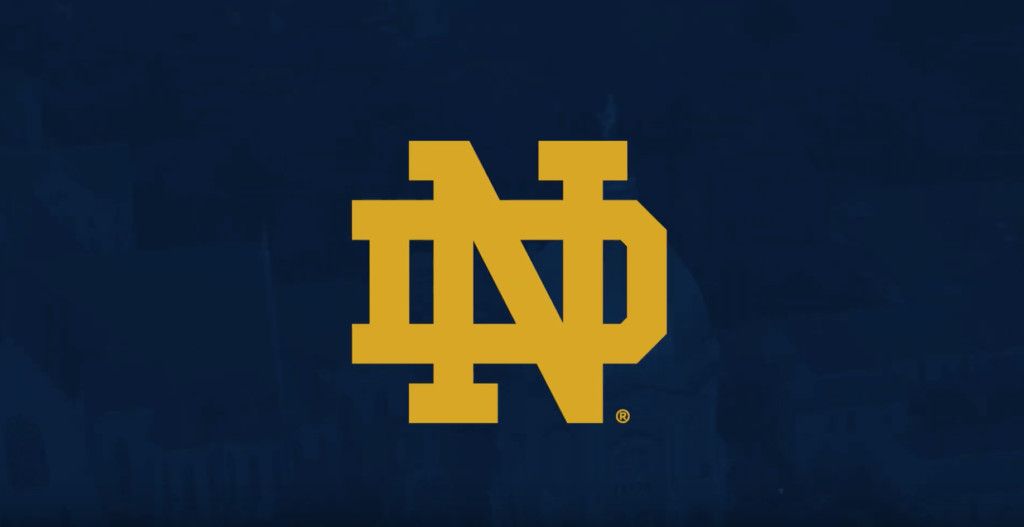Sept. 5, 2003
by John Heisler
The official printed play by play for today’s Notre Dame-Washington State football game will be produced in the Notre Dame Stadium press box soon after the conclusion of the contest.
At the bottom of the scoring summary, the attendance will be listed as the customary 80,795 spectators.
But, if you look a bit closer, you’ll find there are a few empty seats today.
One of those up in the third row of the press box would have been occupied by George Kelly, longtime assistant coach and administrator with the Irish football program and athletic department. His death in early March took from us a passionate fan, a deeply-committed University administrator – and a day-to-day link to the current Notre Dame program for decades worth of former Irish football players.
It’s been almost 20 years since he prowled the sidelines as Irish linebacker coach for Ara Parseghian, Dan Devine and Gerry Faust. But he never lost a smidgen of his zeal for the game, as anyone who has watched him squirm nervously in his coat and tie in a press box can attest. He lived and died with every quarterback sneak, with every tackle, with every substitution – and he reveled in the chances to stay in touch with those who previously wore the gold helmets, whether they ever made a tackle for him or not.
If you ever had a question about how things worked at Notre Dame, George would have the answer. He knew the culture, he knew the people, he understood what it meant to represent the University of Notre Dame. He will be missed by many.
Unfortunately, Kelly was only one of an unusually large number of individuals connected intimately with Notre Dame’s football program and tradition who passed away in a 14-month period.
There was George Connor, the 1946 Outland Trophy winner who died a few weeks after Kelly. A two-time consensus All-America tackle for the Irish, he went on to star for his hometown Chicago Bears, was named to halls of fame at both the college and professional levels – and he might well have been the most accomplished Notre Damer of all-time when you combine both his college and pro achievements. A fixture on the Chicago scene, he was a charter member of the (Frank) Leahy’s Lads gang.
Also missing is Mario “Motts” Tonelli, a Notre Dame fullback under Elmer Layden back in the 1930s and later a Chicago Cardinals back. Another Chicagoan, Tonelli gained all sorts of national attention based on his role in the Bataan Death March during World War II, thanks to 42 months spent in Japanese prison camps. What he found was that the name Notre Dame meant something even worlds away from South Bend, and his prized Notre Dame ring survived based on that recognition alone.
Just a few weeks into the 2002 football season, 1949 Heisman Trophy winner Leon Hart died in a South Bend hospital – maybe appropriately not long after coming to town to see the Irish play yet another football game. All you needed to do was shake hands once with Leon – and find your hand absolutely engulfed by his – and it was not difficult to understand how he was able to terrorize opponents from both sides of the line of scrimmage.
Hart was the heart and soul of the late 1940s Notre Dame teams that didn’t lose a game while he wore an Irish uniform (helping win three national titles in the process) – and his designation as the ’49 Male Athlete of the Year by Associated Press indicated his standing among all his athletic peers.
Two weeks later, in early October of ’02, another Irish Hall of Famer, All-America lineman Jim Martin, passed away. He had joined Hart as two of the last and most successful of Notre Dame’s two-way stars – and he went on to play for the 1950 NFL champion Cleveland Brown team and claim all-pro honors as late as 1961.
Plus, in the spring prior to the ’02 season, Notre Dame lost both Hall of Fame coach Dan Devine, who coached the Irish to the ’77 national title behind the exploits of quarterback Joe Montana, and Hall of Fame halfback Creighton Miller, who led the nation in rushing in 1943 and was called by Leahy the greatest halfback he ever coached. And then there were 1962 captain Mike Lind, 1939 captain Johnny Kelly and 1934 Dom Vairo, who all passed away within the last year.
Current Irish coach Tyrone Willingham’s list of lost lettermen from the 2002 squad included Shane Walton, Jeff Faine, Gerome Sapp, Arnaz Battle, Ryan Roberts, Joey Hildbold, Jordan Black, Sean Mahan, Brennan Curtin and Tom Lopeinski, among others. Those are some big shoes to fill, literally and figuratively, for ’03 squad members.
Notre Dame’s losses in that 14-month period included another impressive list – George Kelly, George Connor, Motts Tonelli, Leon Hart, Dan Devine, Creighton Miller and Jim Martin – five of them members of the College Football Hall of Fame.
As the rookie members of the current Irish team survey the Notre Dame Stadium gameday scene for the first time this afternoon, they’ll have done well if they someday have figuratively filled the shoes of that latter group.







